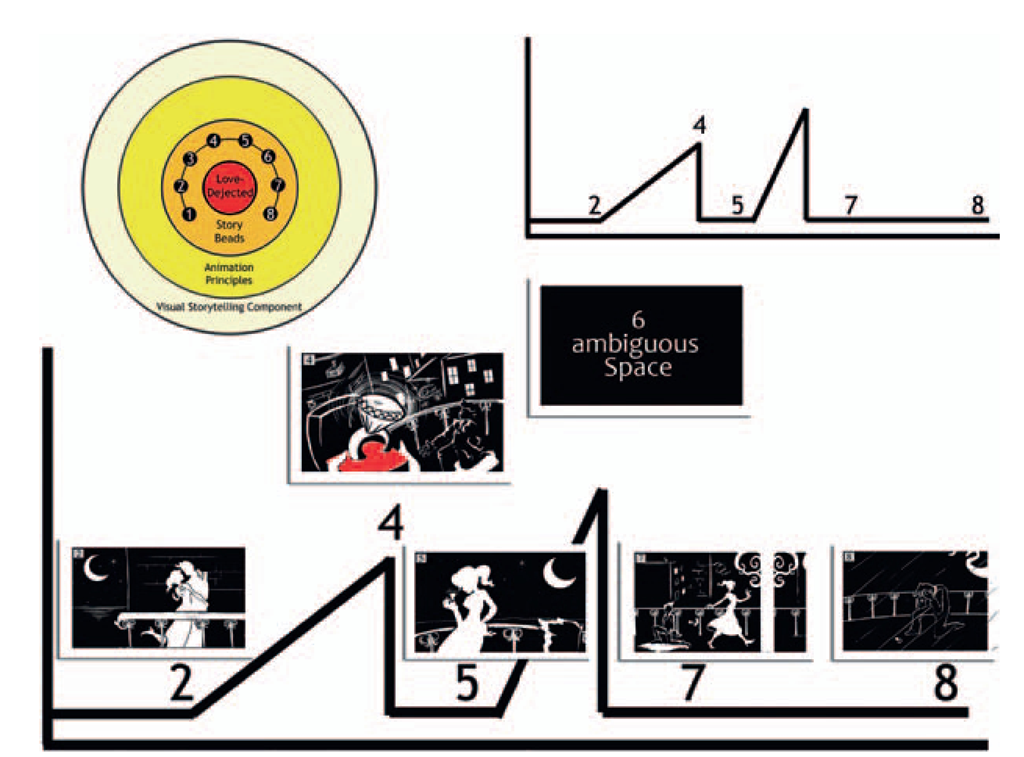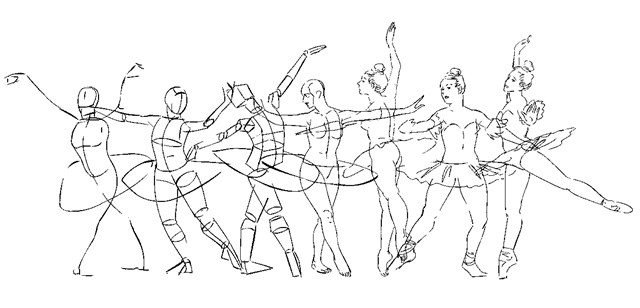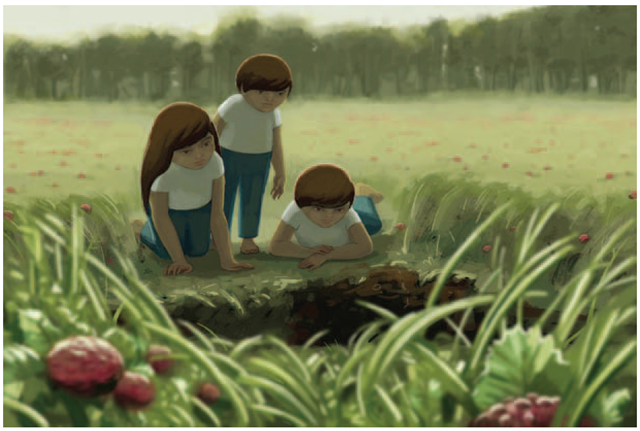Summary
This topic covers how to isolate the most important and strongest emotional storybead/storybeat moments in a film. These “moments" are used to develop the visual target for the story. They are the frontrunners for working out the pipeline issues, isolating technical hurdles, and deciding what it will take to get the shot done and make it look good. It all starts with a visual target. Without it, the artist risks having images that have achieved something technically worthy yet lack any emotion or aesthetic principles.
What Are Iterations?
As an artist, you want to be able to quickly go through different looks, ideas, and concepts so that you can decide whether or not these looks, ideas, or concepts worked. An iteration is the ability to repeat the idea or concept until you get the desired results. What is key is that you are able to iterate quickly. You do not want to spend a lot of time working through one idea only to find out it won’t work! Plus, it is a neat word. Iterations. Throw that one out at a cocktail party. You’ll see the CS (computer science) people nod in approval. In Figure 2.1, you see a series of keyframes as an example of iteration. Each frame shows a different stage or iteration of the drawing process for the figure, from a simple gesture to a human with clothing.
FIGURE 2.1 Iteration is key. Image from Sugar Plum Fairy.
What is a "Moment"?
As we use it in this topic, a “moment" is composed of a style frame and a pipeline test(s) that tries to match that style frame. The term “moment" was used mainly at the Disney studio. I have not encountered it anywhere else. However, to me it is not about the style only, or else we would remain with the commonly used terms “style frame" and “research and development" (R&D). Instead, we use the term “moment" in my class and in this topic because it emphasizes that the style frame and R&D are coupled. Together they should be a “moment." The emotional moment is something that I believe should be upheld from the beginning or else it gets lost in the technical details. If you forget to focus on the emotion you are trying to display (no matter what cool new tool or technique you are going to use to show it), you risk having an animation that does not elicit an emotional response from your audience. It would be a shame to miss the emotional target after all of your hard work.
Creating a Moment is a Two-Stage Process
Step 1: style Frame
First a single frame is created that depicts a key emotional moment in the story. We’ll refer to this single frame as a style frame. Often, concept art has been developed in the previsualization stage and can be used as this visual target. This image is a visual guide and has been created to establish the visual style of the film with any artistic technique. It does not, and usually is not, created with the tools and pipeline that will be used in the film.
FIGURE 2.2 Style frame for Three Magicians.
What medium should be used for the visual target concepts? Personally, I prefer anything but 3D: traditional painting, Photoshop, Painter, markers, pencil, pen and ink. An artist who starts with a 3D pristine image will end up with just that: a 3D pristine image. However, an artist who starts with an energetic marker comp, with bold shading and gestural lines, is forced to push his or her images further than the natural coldness that 3D lends itself toward.
Step 2: Production techniques/Pipeline tests
The second stage is to choose a scene and create an image from the scene (or multiple keyframes from the scene) using techniques that could be used in the film. The goal is to use the original style frame as a divining rod. The artist works with different tool sets, software packages, and pipelines to get as close to the visual target as possible while keeping an eye on the best way to achieve it.
FIGURE 2.3 Storyboard, style frame, and final moment from Three Magicians.
The second stage is basically research and development. However, I cannot stress how important it is that we keep a look at the visual target as our goal. So, often it is the research and development—the technology—that leads the scene, instead of the desired look.
What is The Best "Moment"?
Let us take a look at that bull’s-eye diagram again, shown in Figure 2.4. We have discussed that the inner circle represents the central emotion. Every scene should have some type of emotion that you are trying to get the audience to feel.
Note, I am not saying that the character feels it or that the shot has emotion. No. Your goal is to make the audience feel an emotion. You will need to employ every trick that you can think of to get their brains to call up a memory that causes the desired emotional response. Don’t forget it. Every shot should have an emotion, even if it is only sustaining the emotion from the previous shots. Not every shot is an Oscar-winning performance. Sometimes shots are simply shots that get a character from A to B. However, all shots should maintain the current rings of the bull’s-eye. Every frame in the shot should be targeted toward the center of the bull’s-eye’s emotion. But not all shots are high emotional conveyances.
When you choose what moment to put through your pipeline tests, you should make sure it contains the shots with the strongest, most pivotal emotions in your story. You want to make sure that you can display them correctly and uphold that emotion. What horror would it be if you couldn’t visually pull off the shot where the prince finally kisses the princess?
FIGURE 2.4 Bull’s-eye diagram and its central emotion.
You’ll note that the second ring in the bull’s-eye is for the sto-rybeats that we developed in the previous topic. It is important that all of these storybeats, of course, support the emotion of the story. If this is unfamiliar to you, please refer to the handout “Hitting the Emotional Target" found on the companion website.
A Note on Moments Versus Visual Development
Students often ask the difference between moments and visual development. Visual development is a process whereby artists research and define what the visual style of the film might be. This happens during the previsualization stage.Creating moments in your animation piece comes after the visual development stage. What we create in this topic are the first tries at production work, beyond the previsualization stage.Therefore, you will find that we focus on only the areas in the production process that are different for 2D/3D animation.
Why Pick an Emotional Moment?
Picking such a strong emotional moment serves two purposes: it creates a strong visual glossary and it creates great images for you to use.
First off, using a compelling emotional shot from your film helps establish its mood by giving your viewers an image that shows them what the film should look and feel like. You might all agree at the storyboard stage that things should be “painterly and sad," but until an image is created that is “painterly and sad" everyone has their own image of what “painterly and sad" is. Once an image is created that the art director approves, then there is something visual that can be passed around, used as direction, and used to communicate the actual definition of “painterly and sad" that can be created using the production tools. These images should be posted in well-lit, highly populated areas so that all see them. As the film progresses, if the style focus changes, these images should be updated accordingly. Again, this is beyond concept art. This effect is created using production methods. This is very important. Oftentimes the concept art is great but the final look achieved by the production is far different and misses the emotional impact.
The second purpose of picking a high emotional point in the film is a self-serving one: advertising and promotion (to the outside world and to the team). Whether you need a few compelling images to create a press kit with and pass around to encourage someone to buy your project, to fuel an advertising department, or to inspire your team with what a great project they have signed up for, strong emotional style frames will provide the best images for this need.





